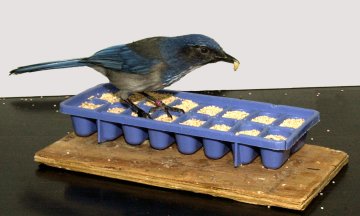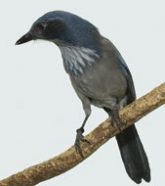A meal plan for birds
Scrub jays do a bird version of planning ahead for their next meal.
Share this:
- Share via email (Opens in new window) Email
- Click to share on Facebook (Opens in new window) Facebook
- Click to share on X (Opens in new window) X
- Click to share on Pinterest (Opens in new window) Pinterest
- Click to share on Reddit (Opens in new window) Reddit
- Share to Google Classroom (Opens in new window) Google Classroom
- Click to print (Opens in new window) Print
By Emily Sohn
If you want to make waffles for breakfast, you have to plan ahead. First, you need to stock up on ingredients at the grocery store. Then, you need to mix the batter and remember where you stashed the waffle iron.
Birds don’t make waffles, but the results of new research suggest that western scrub jays do a bird version of thinking for their morning meals. It could be the best example yet of other animals planning ahead.
 |
|
A western scrub jay stores food where it expects that food won’t otherwise be available the next day.
|
| Ian Cannell & Caroline Raby |
Lots of animals behave in ways that suggest they have an eye on the future. Geese, for example, fly south for the winter. After a day home alone, my cat runs to the front room when she hears me fumbling with my keys outside the door. Plenty of dogs do the same thing.
In cases such as these, however, the animals aren’t necessarily planning. They may simply be acting in response to a signal that’s built-in or learned.
Nuts are a major part of the scrub jay’s diet, and the birds normally store extra nuts by burying them. To test for planning behavior in scrub jays, researchers from the University of Cambridge in England put the birds in chambers with two side rooms. In the first part of the experiment, the researchers ground up the birds’ food so that they couldn’t store it.
On some mornings, the scrub jays were kept for 2 hours in one of the side rooms with no breakfast. On other mornings, birds were locked in the other side room, which had ground-up food. This phase of the study taught the birds that food was always available in one room but never in the other.
Then, the scientists gave eight scrub jays an evening surprise. For once, the jays could eat as many whole pine nuts as they wanted. They could also stash extras wherever they wanted.
 |
|
A western scrub jay.
|
| Clayton Lab |
And they did: The birds put most of their nuts in the room where breakfast was never served. It was as if they were putting waffle mix in an empty pantry for the next day.
In a second experiment, the scientists put peanuts in one side room and food pellets in the other. The birds learned which room was which. Then, during an evening session, the scientists gave the birds the opportunity to store both types of food.
The birds stashed more peanuts in the pellet room and more pellets in the peanut room. It would be as if you put maple syrup in a room full of waffles and waffles in a room full of syrup.
These are the first tests in any animal to meet the definition of animal planning, says Sara Shettleworth of the University of Toronto in Canada.







